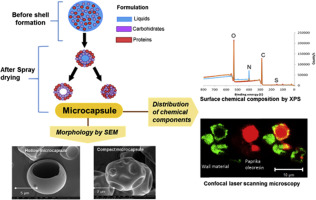当前位置:
X-MOL 学术
›
Food Hydrocoll.
›
论文详情
Our official English website, www.x-mol.net, welcomes your
feedback! (Note: you will need to create a separate account there.)
Chemical components distribution and morphology of microcapsules of paprika oleoresin by microscopy and spectroscopy
Food Hydrocolloids ( IF 11.0 ) Pub Date : 2018-08-01 , DOI: 10.1016/j.foodhyd.2018.02.005 Josefina Porras-Saavedra , Liliana Alamilla-Beltrán , Luis Lartundo-Rojas , Ma. de Jesús Perea-Flores , Jorge Yáñez-Fernández , E. Palacios-González , Gustavo F. Gutiérrez-López
Food Hydrocolloids ( IF 11.0 ) Pub Date : 2018-08-01 , DOI: 10.1016/j.foodhyd.2018.02.005 Josefina Porras-Saavedra , Liliana Alamilla-Beltrán , Luis Lartundo-Rojas , Ma. de Jesús Perea-Flores , Jorge Yáñez-Fernández , E. Palacios-González , Gustavo F. Gutiérrez-López

|
Abstract Microencapsulates containing oleoresin of paprika (OP) and blends of soy protein isolate (SPI), maltodextrin (MD) and gum arabic (GA) as wall materials, were analysed to evaluate the components distribution developed during the encapsulation process. Encapsulation efficiency, glass transition temperature, flowability and physical properties were also assessed. Focused ion beam coupled to scanning electron microscopy (FIB-SEM), confocal laser scanning microscopy (CLSM), X-ray dispersion spectroscopy (EDX) and X-ray photoelectron spectroscopy (XPS) allowed identifying the effects of OP into microcapsules, chemical components distribution, and morphology. In microencapsulated OP, the hollow capsules ranged from 8 to 23% and Tgs (near to 83 °C and 98 °C). The protein concentration on particle surface (18.08%–68.48%) was evaluated by XPS and the surface composition of powders was identified. The best encapsulation efficiency (88.4%) was exhibited by the formulation OP-0.10% SPI-10.45% MD-9.45% GA; the capsules showed the lowest wall thickness and the maximum nitrogen reduction (%) on the particle surface. As a conclusion, OP reduces the presence of hollow capsules and increases the Tg; the soy protein may be responsible for the folds with wide crests on the particle surface, giving a soft and active surface. Although the stability of oleoresin of paprika microencapsulated is associated with the low values of moisture content, aw, and glass transition temperature, the OP on the external surface, could reduce the protective capacity of any wall material.
中文翻译:

显微镜和光谱学研究辣椒油树脂微胶囊的化学成分分布和形态
摘要 分析含有辣椒油树脂 (OP) 和大豆分离蛋白 (SPI)、麦芽糊精 (MD) 和阿拉伯树胶 (GA) 混合物作为壁材料的微胶囊,以评估在封装过程中形成的成分分布。还评估了封装效率、玻璃化转变温度、流动性和物理特性。聚焦离子束与扫描电子显微镜 (FIB-SEM)、共聚焦激光扫描显微镜 (CLSM)、X 射线色散光谱 (EDX) 和 X 射线光电子能谱 (XPS) 耦合,可以识别 OP 对微胶囊、化学成分的影响分布和形态。在微胶囊化 OP 中,空心胶囊的范围为 8% 至 23%,Tgs(接近 83 °C 和 98 °C)。颗粒表面的蛋白质浓度 (18.08%–68. 48%) 通过 XPS 评估并确定粉末的表面组成。OP-0.10% SPI-10.45% MD-9.45% GA的配方表现出最佳的包封效率(88.4%);胶囊在颗粒表面显示出最低的壁厚和最大的氮减少量 (%)。总之,OP 减少了空心胶囊的存在并提高了 Tg;大豆蛋白可能负责在颗粒表面形成具有宽峰的褶皱,从而提供柔软且活跃的表面。尽管微囊化辣椒油树脂的稳定性与水分含量、aw 和玻璃化转变温度的低值有关,但外表面的 OP 会降低任何壁材料的保护能力。4%)由制剂 OP-0.10% SPI-10.45% MD-9.45% GA 表现出来;胶囊在颗粒表面显示出最低的壁厚和最大的氮减少量 (%)。总之,OP 减少了空心胶囊的存在并提高了 Tg;大豆蛋白可能负责在颗粒表面形成具有宽峰的褶皱,从而提供柔软且活跃的表面。尽管微囊化辣椒油树脂的稳定性与水分含量、aw 和玻璃化转变温度的低值有关,但外表面的 OP 会降低任何壁材料的保护能力。4%)由制剂 OP-0.10% SPI-10.45% MD-9.45% GA 表现出来;胶囊在颗粒表面显示出最低的壁厚和最大的氮减少量 (%)。总之,OP 减少了空心胶囊的存在并提高了 Tg;大豆蛋白可能负责在颗粒表面形成具有宽峰的褶皱,从而提供柔软且活跃的表面。尽管微囊化辣椒油树脂的稳定性与水分含量、aw 和玻璃化转变温度的低值有关,但外表面的 OP 会降低任何壁材料的保护能力。OP减少空心胶囊的存在并提高Tg;大豆蛋白可能负责在颗粒表面形成具有宽峰的褶皱,从而提供柔软且活跃的表面。尽管微胶囊化辣椒粉油树脂的稳定性与水分含量、aw 和玻璃化转变温度的低值有关,但外表面的 OP 会降低任何壁材料的保护能力。OP减少空心胶囊的存在并提高Tg;大豆蛋白可能负责在颗粒表面形成具有宽峰的褶皱,从而提供柔软且活跃的表面。尽管微囊化辣椒油树脂的稳定性与水分含量、aw 和玻璃化转变温度的低值有关,但外表面的 OP 会降低任何壁材料的保护能力。
更新日期:2018-08-01
中文翻译:

显微镜和光谱学研究辣椒油树脂微胶囊的化学成分分布和形态
摘要 分析含有辣椒油树脂 (OP) 和大豆分离蛋白 (SPI)、麦芽糊精 (MD) 和阿拉伯树胶 (GA) 混合物作为壁材料的微胶囊,以评估在封装过程中形成的成分分布。还评估了封装效率、玻璃化转变温度、流动性和物理特性。聚焦离子束与扫描电子显微镜 (FIB-SEM)、共聚焦激光扫描显微镜 (CLSM)、X 射线色散光谱 (EDX) 和 X 射线光电子能谱 (XPS) 耦合,可以识别 OP 对微胶囊、化学成分的影响分布和形态。在微胶囊化 OP 中,空心胶囊的范围为 8% 至 23%,Tgs(接近 83 °C 和 98 °C)。颗粒表面的蛋白质浓度 (18.08%–68. 48%) 通过 XPS 评估并确定粉末的表面组成。OP-0.10% SPI-10.45% MD-9.45% GA的配方表现出最佳的包封效率(88.4%);胶囊在颗粒表面显示出最低的壁厚和最大的氮减少量 (%)。总之,OP 减少了空心胶囊的存在并提高了 Tg;大豆蛋白可能负责在颗粒表面形成具有宽峰的褶皱,从而提供柔软且活跃的表面。尽管微囊化辣椒油树脂的稳定性与水分含量、aw 和玻璃化转变温度的低值有关,但外表面的 OP 会降低任何壁材料的保护能力。4%)由制剂 OP-0.10% SPI-10.45% MD-9.45% GA 表现出来;胶囊在颗粒表面显示出最低的壁厚和最大的氮减少量 (%)。总之,OP 减少了空心胶囊的存在并提高了 Tg;大豆蛋白可能负责在颗粒表面形成具有宽峰的褶皱,从而提供柔软且活跃的表面。尽管微囊化辣椒油树脂的稳定性与水分含量、aw 和玻璃化转变温度的低值有关,但外表面的 OP 会降低任何壁材料的保护能力。4%)由制剂 OP-0.10% SPI-10.45% MD-9.45% GA 表现出来;胶囊在颗粒表面显示出最低的壁厚和最大的氮减少量 (%)。总之,OP 减少了空心胶囊的存在并提高了 Tg;大豆蛋白可能负责在颗粒表面形成具有宽峰的褶皱,从而提供柔软且活跃的表面。尽管微囊化辣椒油树脂的稳定性与水分含量、aw 和玻璃化转变温度的低值有关,但外表面的 OP 会降低任何壁材料的保护能力。OP减少空心胶囊的存在并提高Tg;大豆蛋白可能负责在颗粒表面形成具有宽峰的褶皱,从而提供柔软且活跃的表面。尽管微胶囊化辣椒粉油树脂的稳定性与水分含量、aw 和玻璃化转变温度的低值有关,但外表面的 OP 会降低任何壁材料的保护能力。OP减少空心胶囊的存在并提高Tg;大豆蛋白可能负责在颗粒表面形成具有宽峰的褶皱,从而提供柔软且活跃的表面。尽管微囊化辣椒油树脂的稳定性与水分含量、aw 和玻璃化转变温度的低值有关,但外表面的 OP 会降低任何壁材料的保护能力。











































 京公网安备 11010802027423号
京公网安备 11010802027423号